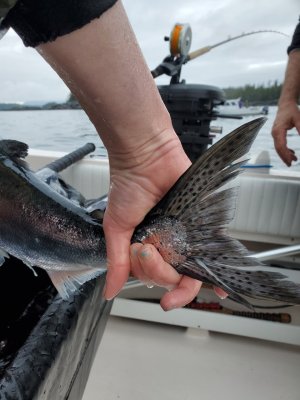searun
Well-Known Member
There is nothing I can find in the regulations prohibiting use of tandem hooks - so there probably isn't anything to look up....its totally legal to use tandems. Legal or not, its still an ethical consideration to limit the number of hooks.
Legal or not, I still believe we should try to amend the tackle we use to reduce the impact (or FRIM) on those fish we release - fewer hooks, smaller hook gaps = less probability of deep wounds that will lead to unanticipated mortality.
Bit shocking hearing about some guy in Rivers who is supposedly using 3 trebbles - Rivers is not a "meat" fishery - seems to me that most people participating in that fishery aren't looking to kill every fish that comes to the boat. Lot of research out there on the impact of trebble hooks vs single hooks - especially on smaller fish - granted many of the studies are on trout and not large mature Chinook. So I admit that when it comes to hook style and gap of hook, size of the fish encountered will be a significant determining variable in hook mortality. Nevertheless, 3 trebbles is questionable practice IMO.
Same for avoiding using nets of any kind (even soft mesh so called release nets). I have seen a lot of damage (fin damage, loss of scales and slime) from even the best release net. If we are planning to release fish, IMO it is best practice to simply use a gaff to remove the hook while the fish is in the water. Less handling = less probability of injury - not rocket surgery.
Another reason I don't use tandem hooks on hoochies is it is far easier to do a gaff release with only one hook to deal with.
I fully appreciate these are not easy conversations, and certainly limiting FRIM is new ground the recreational fishery is now only starting to investigate and adopt our practice. However, seems like the right thing to do if our goal is to have long-term sustainable recreational fisheries for future generations.
Legal or not, I still believe we should try to amend the tackle we use to reduce the impact (or FRIM) on those fish we release - fewer hooks, smaller hook gaps = less probability of deep wounds that will lead to unanticipated mortality.
Bit shocking hearing about some guy in Rivers who is supposedly using 3 trebbles - Rivers is not a "meat" fishery - seems to me that most people participating in that fishery aren't looking to kill every fish that comes to the boat. Lot of research out there on the impact of trebble hooks vs single hooks - especially on smaller fish - granted many of the studies are on trout and not large mature Chinook. So I admit that when it comes to hook style and gap of hook, size of the fish encountered will be a significant determining variable in hook mortality. Nevertheless, 3 trebbles is questionable practice IMO.
Same for avoiding using nets of any kind (even soft mesh so called release nets). I have seen a lot of damage (fin damage, loss of scales and slime) from even the best release net. If we are planning to release fish, IMO it is best practice to simply use a gaff to remove the hook while the fish is in the water. Less handling = less probability of injury - not rocket surgery.
Another reason I don't use tandem hooks on hoochies is it is far easier to do a gaff release with only one hook to deal with.
I fully appreciate these are not easy conversations, and certainly limiting FRIM is new ground the recreational fishery is now only starting to investigate and adopt our practice. However, seems like the right thing to do if our goal is to have long-term sustainable recreational fisheries for future generations.


